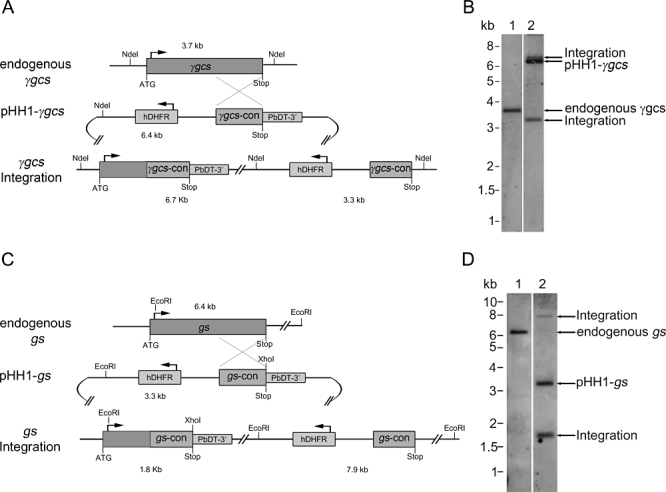Figure 3.

Targeting of γgcs and gs loci is possible. A. Schematic diagram of the endogenous γgcs locus, the pHH1-γgcs plasmid and the recombined γgcs locus following single cross-over recombination between the plasmid and the 3′ region of γgcs. The plasmid contains a human dihydrofolate reductase selectable marker (hDHFR) cassette, a region homologous to the 3′ end of γgcs (γgcs-con) allowing for recombination with the target gene and an artificial 3′ UTR (P. berghei dihydrofolate reductase/thymidylate synthase 3′ UTR, PbDT-3′). NdeI restriction sites and sizes of the resulting diagnostic DNA fragments are indicated. B. Southern blot of wild-type parasites (lane 1) in comparison with a representative clone (lane 2) in which the γgcs locus has been targeted by the pHH1-γgcs control plasmid. The 3.7 kb endogenous γgcs band was only visible in the wild type (lane 1). In the cloned parasites (lane 2) two bands (3.3 kb and 6.7 kb) diagnostic for integration of the plasmid into the γgcs gene locus were detected. The pHH1-γgcs plasmid (6.4 kb) was still present in the cloned parasite line. C. Schematic diagram of the gs locus, the pHH1-gs plasmid and the recombined gs locus following integration. The plasmid contains an hDHFR selectable marker cassette and a homologous fragment to the 3′ end of gs (gs-con) with an artificial downstream 3′ UTR (PbDT-3′). EcoRI and XhoI restriction sites used for diagnostic digest and Southern blotting are indicated as well as the sizes of the resulting DNA fragments. D. Southern blot analysis of wild-type parasites (lane 1) in comparison with a representative cloned parasite line (lane 2) bearing the recombined gs locus following integration of pHH1-gs. The 6.4 kb band corresponding to endogenous gs was only detectable in the DNA isolated from wild-type parasites. In the cloned parasite line two bands specific for integration in the gs gene locus of 1.8 kb and 7.9 kb were visible (lane 2). The plasmid (3.3 kb) was still detectable in the cloned parasite line.
